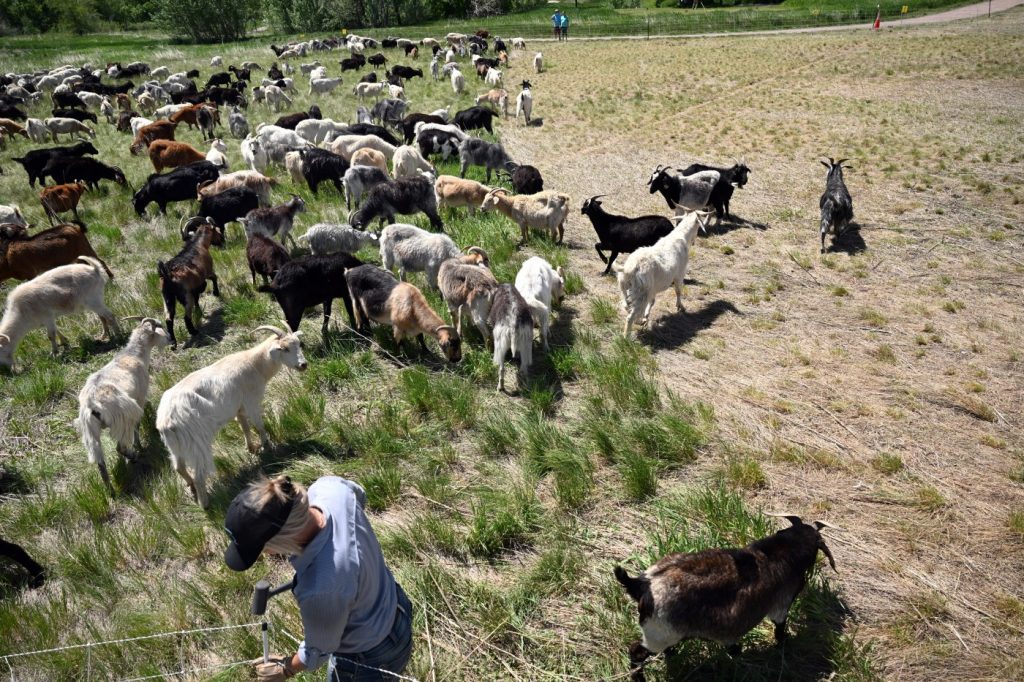SUPERIOR, Colorado — The hundreds of goats munching dead vegetation on a patch of roadside open space represent this Boulder County town’s latest effort at staving off wildfires.
The goats, encircled by electric fencing and guarded by herding dogs, were grazing Wednesday between a residential neighborhood and the El Dorado K-8 School near the intersection of Mount Sopris Parkway and Indiana Street.
Just up the road marks the bounds of the Marshall fire, Colorado’s most destructive wildfire that killed two people and destroyed more than $2 billion worth of property in Superior, Louisville and unincorporated Boulder County in December 2021.
Investigators concluded the disastrous blaze began with reignited embers on the grounds of an international religious cult and from sparks from a broken power line about 2,000 feet away. The flames were driven by high winds and dried grass and brush, according to a 17-month investigation into the fire’s origin.
An aerial photo after the Marshall fire shows a total loss of all the homes in the subdivision to the west of Superior’s historic downtown area on January 2, 2022, in Superior, Colorado. (Photo by Helen H. Richardson/The Denver Post) Helen H. Richardson, The Denver Post
After the Marshall fire, Colorado municipalities took a greater interest in managing their vegetation, said Leslie Clark, Superior’s parks, recreation and open space director. Both Louisville and Superior are employing weed-chomping goats to better tame the landscape.
“Our open space, traditionally, was handled pretty hands-off as far as vegetation, whereas now we’re taking a more proactive approach to reduce fuel loads and other fire mitigation practices,” Clark said. “Goat grazing really hits that on the head because it helps us reduce both current growth and the old, dried-up dead stuff that’s there. They love to eat the weeds and weed reduction is a big part of our wildlife mitigation. because weeds tend to burn a little bit hotter and longer than native grass.”
Using goats for wildfire mitigation isn’t new, but it has grown in popularity in the past decade and really picked up after the Marshall fire, said Donny Benz, who runs the goat grazing business Goat Green LLC with his mother Lani Malmberg.
Goat Green LLC has about 1,500 goats that are sent around the state to eat, bleat and repeat — including, at the moment, in Louisville.
Malmberg started the business, primarily focused on weed-eating, in 1996 after earning her master’s degree in weed science at Colorado State University.
“I got the idea you should take an animal that eats whatever the problem is as an alternative to machinery and pesticides,” Malmberg said.
Donny Benz, left, and his fiancé Kaiti Singley, right, with Goat Green LLC, monitor their Cashmere goats as they graze in fields in Dutch Creek Open Space in Louisville, Colorado, on May 22, 2024. As the goats eat, they create natural firebreaks that help to prevent and slow down wildfires. (Photo by Helen H. Richardson/The Denver Post)
Now, Malmberg and Benz offer up their goats to private land owners, homeowner’s associations, Air Force bases, the Bureau of Land Management and a number of cities across the West including — in Colorado — Westminster, Erie, Castle Rock and Broomfield.
Currently, the duo has a herd feasting in Louisville off of the Dutch Creek Open Space. Louisville has a $45,000 goat-grazing contract this year that includes herd activity in the spring and the fall, city officials said.
“We don’t sell for slaughter, so our animals are born with us, work every day of their lives for us and die with us,” Malmberg said. “It’s generational. The goats and border collies are generational, and we, the people, are generational. We all have the experience.”
Malmberg said she quoted the Superior open space department $14,000 for fire mitigation services in April 2021, months before the Marshall fire, but was told her services were too expensive.
“That’s not to say we could have prevented it, but it may have helped,” Benz said.
An important part of fire mitigation, Benz said, is clearing away low-growing vegetation like grasses, low-lying tree branches and shrubs to prevent flames from climbing to taller vegetation like trees. This is called the fire ladder, he said.
Goats are unique in addressing this issue, Malmberg said, because they can stand on their hind legs to eat low-hanging branches.
The goats, she said, typically eat for a few hours, then lay down and chew their cud for a few hours and digest — and, somewhere in there, naturally fertilize and manage the soil.
Their hooves pack the soil into the ground, preventing mudslides and erosion, Malmberg said.
“It’s like a massage for the land,” she said.
The Superior goats, managed by Goat Bros Hoof-Action Grazing, will be chowing down in their new workplace through Sept. 2. Superior is paying roughly $1,000 a day to use 300 goats for 78 days of grazing this year, town officials said.
A few days before the Superior goats finish grazing their 30 acres, Clark said the town will sprinkle native and pollinator seeds throughout the area so the animals can walk on the seeds, help sow the soil and promote water infiltration of the plants with their hooves.
Onlookers are welcomed but asked not to breach the electric fence and to let the goats do their jobs.
Benz said the entertainment factor of the goats is part of the draw, not to mention a good opportunity to educate the public about fire mitigation.
“Nobody stops to watch someone spray or mow, but we had about 1,000 people in the open space last night visiting from about 5 p.m. to 7 p.m.,” Benz said. “There are so many people out there — all these children looking at goats — and people ask why all these goats are out here, so we tell them.”
Hudson Coombs, 3, who was out with his grandfather Earle Harder, not pictured, checks out Cashmere goats belonging to Goat Bros Hoof-Action Grazing that are being used for fire mitigation in Superior, Colorado, on May 23, 2024. (Photo by Helen H. Richardson/The Denver Post)


